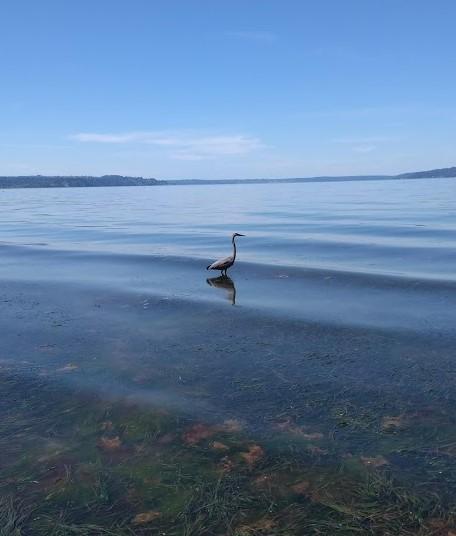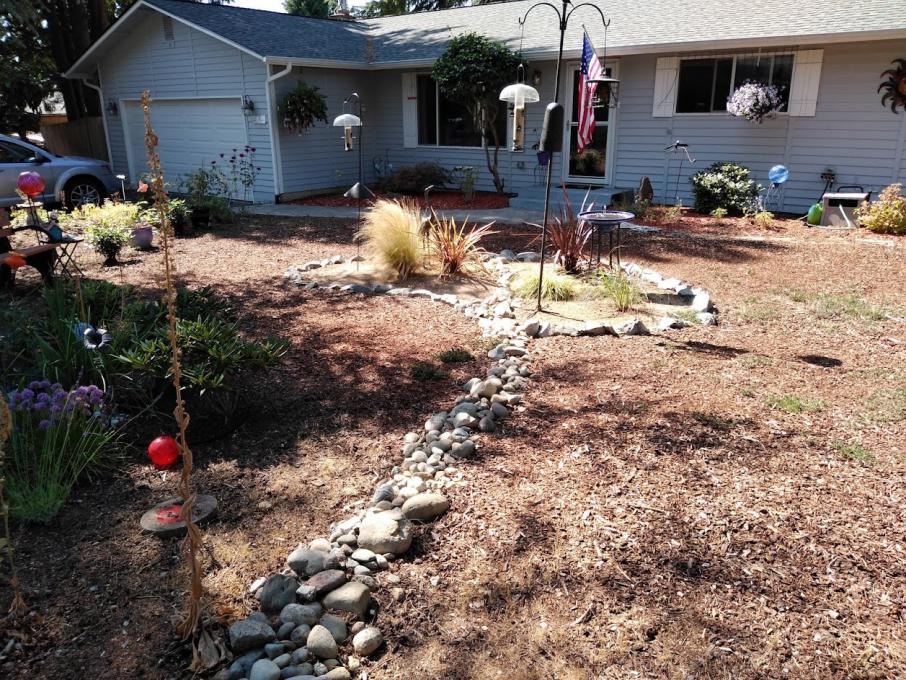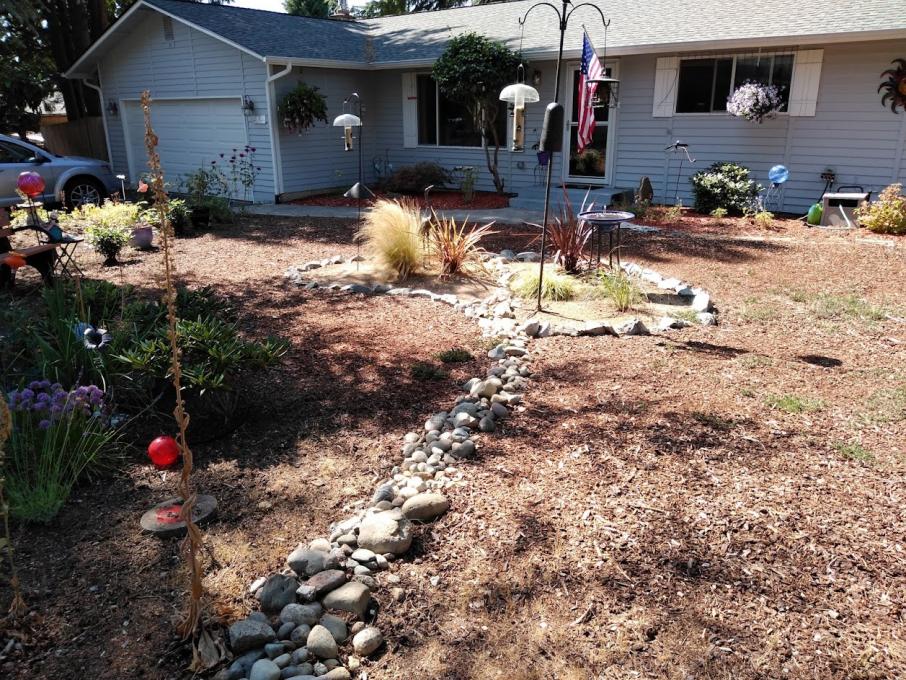Margo
Forum Replies Created
Viewing 10 posts - 1 through 10 (of 10 total)
-
MargoParticipantWhen I'm in my yard south of Seattle, I love the Pileated Woodpeckers and Northern Flickers that some to eat the suet in my feeders. Sorry, no pictures. I love the orange color of the flicker's tail feathers. I had an adult Pileated Woodpecker one day with a juvenile. I watched as the adult taught the juvenile how to eat out of the suet feeder!! In the summer months, I volunteer as a beach naturalist. I'm working to learn and identify Seabirds, Wading Birds, and Shorebirds. I also live near a heron sanctuary; so it probably won't surprise you that the Great Blue Heron is a favorite of mine.
 in reply to: Activities: Exploring Birds #840307
in reply to: Activities: Exploring Birds #840307 -
MargoParticipantMy ecoregion is Marine West Coast Forest, which is very true for my yard just south of Seattle, WA. I'm in zone 8a-b. Most of the lawn here was removed before we moved in five years ago, and I removed the rest. We have a heavily wooded lot, lots of pine cones for birds feeding. The soil is more sandy than anything else, very poor quality due to the yard being covered by black plastic and fabric years ago. I am spending a lot of time working to improve the soil with mulch. I've added vertical features for birds to sit on and turned the front yard into a park like environment - dry pond, two park benches, two birdbaths grasses. This is the first year I've seen birds actually bathing, not just drinking out of the birdbaths! I even had an immature Cooper's Hawk sit down in the birdbath and bathe. I'm focusing on native plants to add to the yard. I have two new Mahonia plants, and I've read that birds eat the berries. I haven't seen any evidence of that so far. Coneflower and hypericum are attracting birds, and my bee balm was a hummingbird favorite along with my hardy fuchsia. Adding to my non-plan, I want to include a blueberry bush and maybe a crabapple tree. My backyard is really shaded about 90%+ of the time. I am struggling to create a bird friendly environment there. I do have a popular birdbath there, plus a suet feeder that is beloved by Northern Flickers. I need to identify more shade loving native plants.in reply to: Gather Your Local Knowledge #836691
-
MargoParticipantI loved your comment about the 6' x 6' blueberry bush. I also don't have a plan, although I think I have been trial and error planning for the past four years. I want to add a blueberry bush (smaller than 6'!) and a crab apple tree. I have been paying much more attention to native plants and plants that attract birds. I liked the idea from the previous lesson - 2/3 for the birds.in reply to: Gather Your Local Knowledge #836689
-
MargoParticipantI don't think I was surprised, and I'm satisfied that our yard already includes many bird friendly features. I can't take all the credit. When we moved in five years ago, there was little lawn. Removing what was left wasn't that hard! We did have an issue with bird strikes in the windows, and one surprise was the recommended distance for feeders to be close to or away from the house. We did install stickers in windows, which weren't very effective. We switched to BirdSavers (https://www.birdwatchingdaily.com/gear/preventing-bird-window-collisions/strings-nettings-screens-prevent-bird-window-collisions/) two years ago, and those have worked very well. You are right. After a while, you don't even notice them. I have had to work at embracing some messiness. It is harder than I expected to not rake or rake toward gardens, but leave the leaves! Leaving limbs and having a rough area in the yard is working fine. With the range of birds that visit, some of the plants I have added have been eaten pretty quickly by the combination of birds, rabbits, and squirrels. At least I don't have deer! I laugh every time I read a comment about leaving the coneflower heads to the birds can eat the seeds. Some hungry animal eats the heads off the flowers before anyone gets to the seed heads. I would welcome suggestions for berries and nuts that work in the Pacific Northwest. I do have Oregon grape and beauty berry in my yard. I'm thinking of adding a native blueberry. I do have pines and evergreens and lots of pinecone seeds. Thanks for any suggestions.in reply to: Keys to Gardening for Birds #835871
-
MargoParticipantI agree and like you am working to reduce my birds relying on feeders. Our area of WA State had a terrible experience with pine siskin finch swarming and an outbreak of salmonella area wide. I hope I don't see that again. I have many recommended features in my yard already, but the yard is pretty thin on nuts and berries.in reply to: Keys to Gardening for Birds #835869
-
MargoParticipantFor years now I have not "cleaned up" the plants, seed heads, etc. in my garden. I leave the seeds and stalks for winter birds. I am really working to improve the food I provide for birds from plants rather than seed and suet feeders.in reply to: Joys of Naturescaping #834404
-
MargoParticipantI live in WA State, and when we bought this house it had no lawn! We've never lived on a property with no lawn before. You certainly look at a yard and garden differently! The previous owners had hummingbird feeders; so I added those first. I tried a seed feeder in the backyard, but I attracted no birds. Most of my feeders are now in the front yard, and the number of bird visitors has just grown and grown. As I've added plants, the birds certainly don't seem to mind that there is no lawn!in reply to: Joys of Naturescaping #834402
-
MargoParticipantThis looks so lovely and peaceful. What birds do you attract to this area? While I live in WA State, I am also working toward more native plants, especially as a food source. I do have birds year round, including Anna's hummingbirds. Do you have any bird feeders?in reply to: Joys of Naturescaping #834401
-
MargoParticipant
 My front and backyard are huge, with little area that supports gardening. The area is heavily wooded, and the soil quality is not great. I do have several areas that support some gardening, almost like gardening zones. We moved here five years ago, and I am reading more and more about woodland gardening! I have been a bird feeder for over 30 years, and a gardener at least that long. For most of that time, I saw those activities are parallel, not intersecting. I have many birds visiting. The pileated woodpeckers and Stellar's jays are probably my favorites. I have lived in NJ and WA where the American Goldfinch is the state birds. I never saw one until I moved to WA, and I have dozens visiting! I feed hummingbirds year round. As I inventory my bird tools, I have: 2 seed feeders, 2 suet feeders, 3 hummingbird feeders, and 3 birdbaths. Two of the birdbaths have solar features, but my hummingbirds love to fly and linger in the hose spray when I am watering the garden!
I started thinking more about gardening for birds after the pine siskin finch swarming this winter. My area of WA State experienced extreme swarming behavior including the spread of salmonella and the death of hundreds of birds. I had never seen anything like it before, and I brought my feeders in for more than three months. I am focusing now on gardening for birds with a goal of reducing my feeder use and the risk of swarming behavior and disease spread. While the experts say that is a cyclical behavior, I do hope I don't see it again. I would like to offer more native plants and natural food for my bird visitors. I know I will also need to improve the soil in my yard to support more gardening. in reply to: Joys of Naturescaping #834399
My front and backyard are huge, with little area that supports gardening. The area is heavily wooded, and the soil quality is not great. I do have several areas that support some gardening, almost like gardening zones. We moved here five years ago, and I am reading more and more about woodland gardening! I have been a bird feeder for over 30 years, and a gardener at least that long. For most of that time, I saw those activities are parallel, not intersecting. I have many birds visiting. The pileated woodpeckers and Stellar's jays are probably my favorites. I have lived in NJ and WA where the American Goldfinch is the state birds. I never saw one until I moved to WA, and I have dozens visiting! I feed hummingbirds year round. As I inventory my bird tools, I have: 2 seed feeders, 2 suet feeders, 3 hummingbird feeders, and 3 birdbaths. Two of the birdbaths have solar features, but my hummingbirds love to fly and linger in the hose spray when I am watering the garden!
I started thinking more about gardening for birds after the pine siskin finch swarming this winter. My area of WA State experienced extreme swarming behavior including the spread of salmonella and the death of hundreds of birds. I had never seen anything like it before, and I brought my feeders in for more than three months. I am focusing now on gardening for birds with a goal of reducing my feeder use and the risk of swarming behavior and disease spread. While the experts say that is a cyclical behavior, I do hope I don't see it again. I would like to offer more native plants and natural food for my bird visitors. I know I will also need to improve the soil in my yard to support more gardening. in reply to: Joys of Naturescaping #834399 -
MargoParticipant
 in reply to: Joys of Naturescaping #834397
in reply to: Joys of Naturescaping #834397
Viewing 10 posts - 1 through 10 (of 10 total)

 My front and backyard are huge, with little area that supports gardening. The area is heavily wooded, and the soil quality is not great. I do have several areas that support some gardening, almost like gardening zones. We moved here five years ago, and I am reading more and more about woodland gardening! I have been a bird feeder for over 30 years, and a gardener at least that long. For most of that time, I saw those activities are parallel, not intersecting. I have many birds visiting. The pileated woodpeckers and Stellar's jays are probably my favorites. I have lived in NJ and WA where the American Goldfinch is the state birds. I never saw one until I moved to WA, and I have dozens visiting! I feed hummingbirds year round. As I inventory my bird tools, I have: 2 seed feeders, 2 suet feeders, 3 hummingbird feeders, and 3 birdbaths. Two of the birdbaths have solar features, but my hummingbirds love to fly and linger in the hose spray when I am watering the garden!
I started thinking more about gardening for birds after the pine siskin finch swarming this winter. My area of WA State experienced extreme swarming behavior including the spread of salmonella and the death of hundreds of birds. I had never seen anything like it before, and I brought my feeders in for more than three months. I am focusing now on gardening for birds with a goal of reducing my feeder use and the risk of swarming behavior and disease spread. While the experts say that is a cyclical behavior, I do hope I don't see it again. I would like to offer more native plants and natural food for my bird visitors. I know I will also need to improve the soil in my yard to support more gardening.
My front and backyard are huge, with little area that supports gardening. The area is heavily wooded, and the soil quality is not great. I do have several areas that support some gardening, almost like gardening zones. We moved here five years ago, and I am reading more and more about woodland gardening! I have been a bird feeder for over 30 years, and a gardener at least that long. For most of that time, I saw those activities are parallel, not intersecting. I have many birds visiting. The pileated woodpeckers and Stellar's jays are probably my favorites. I have lived in NJ and WA where the American Goldfinch is the state birds. I never saw one until I moved to WA, and I have dozens visiting! I feed hummingbirds year round. As I inventory my bird tools, I have: 2 seed feeders, 2 suet feeders, 3 hummingbird feeders, and 3 birdbaths. Two of the birdbaths have solar features, but my hummingbirds love to fly and linger in the hose spray when I am watering the garden!
I started thinking more about gardening for birds after the pine siskin finch swarming this winter. My area of WA State experienced extreme swarming behavior including the spread of salmonella and the death of hundreds of birds. I had never seen anything like it before, and I brought my feeders in for more than three months. I am focusing now on gardening for birds with a goal of reducing my feeder use and the risk of swarming behavior and disease spread. While the experts say that is a cyclical behavior, I do hope I don't see it again. I would like to offer more native plants and natural food for my bird visitors. I know I will also need to improve the soil in my yard to support more gardening. 